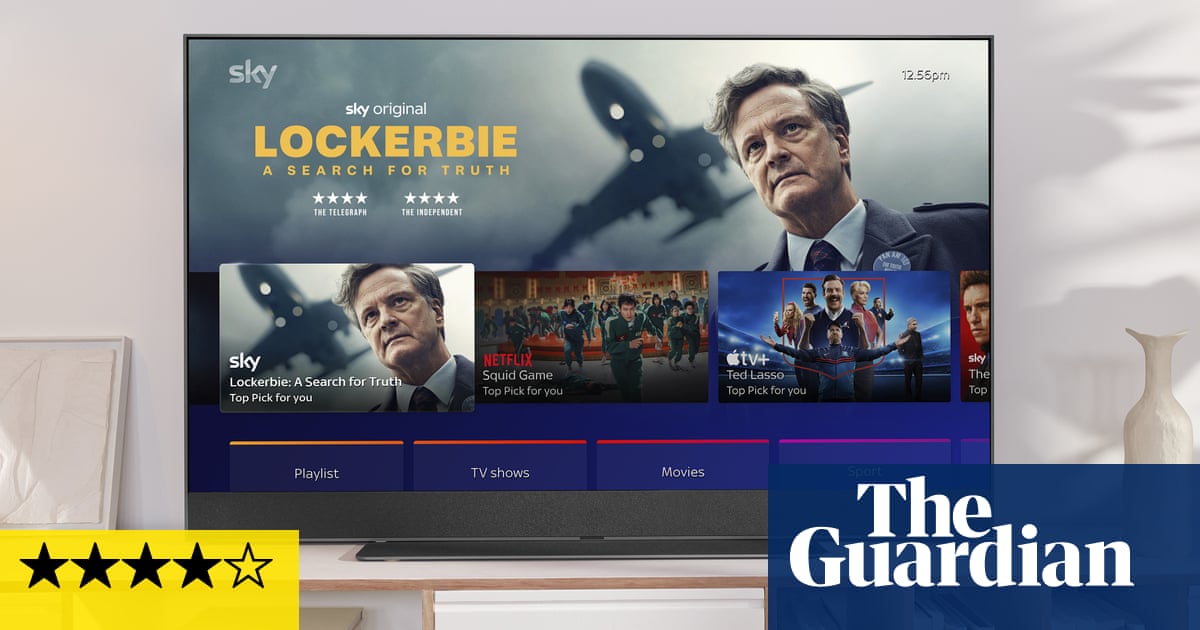The latest version of Sky’s Glass smart TV is faster and looks better than its predecessor and offers a level of all-in-one convenience that makes the satellite-free pay TV one of the best on the market.
Sky Glass gen 2 is a straight replacement for the original model from 2021, which introduced Sky’s TV-over-broadband service that ditched the need for a satellite dish. The new TV comes in three sizes and you can buy the smallest 43in version for a one-off payment of £699 or £14 a month spread over four years, after which you own it.
It requires a Sky subscription for full use, costing from £15 a month for the Sky Essential TV pack. You wouldn’t buy a Glass without the intention of using Sky, but should you want to ditch the subscription at a later date it will function as a basic smart TV with access to streaming apps such as BBC iPlayer, plus a basic aerial and multiple HDMI inputs.
From the front, the gen 2 model looks very similar to the original. It has the same monolithic design with an aluminium body, slim bezels, a soundbar hidden behind a colour-matched mesh at the bottom and voice control mics that respond to “Hello Sky”. Glass gen 2 is thinner and lighter than the outgoing model, though still heavy for a modern TV, weighing 14.7kg for the 43in version with the stand. The larger and heavier 55in and 65in models will require two people to safely manoeuvre them.
A redesigned stand makes it a lot easier to set up, even at the 65in size as tested, with the TV simply slotting on to two prongs for a very stable mount without screws or tools required. It needs a power cable and wifi or Ethernet for internet. A wall bracket can be bought separately.
The crisp 4K LCD screen is noticeably brighter than its predecessor, with deeper blacks and much-reduced halo or blooming effect, which is the unwanted glow around the edges of bright spots such as white text on a black background. The screen has automatic brightness adjustment, which made things look a little too dark and grey in all but the brightest of rooms. Turning it off improved things.
Sky has automatic picture optimisation modes that detect the content being watched, such as entertainment, sport and movies, plus manual vivid and extra vivid modes for those who like over-the-top colours. I found the entertainment mode made the picture too warm, with people looking a little orange, while sport was a bit grey for all but the brightest of match days.
I preferred the movie setting, which is much more balanced, but there is also a custom mode for those who want to fully personalise the picture.
The improved screen really comes to life with HDR films, shows and sport. The Premier League looks crisp and vibrant on Sky and TNT, while flicks such as Furiosa: A Mad Max Saga in Dolby Vision look particularly good. But the screen is not ideal for gaming with an Xbox or PS5, lacking the variable refresh rates of up to 120Hz that console gaming greatly benefits from.
Big sound and great vocals
A big advantage of the Glass over normal TVs is the integrated seven-speaker soundbar, which blows other TV speakers away for power and clarity. Vocals are particularly clear at almost any volume and with none of the lip-sync issues that can plague external soundbars. Without a separate subwoofer or rear speakers, it does an admirable job of producing big and full sound.
However, it struggles to produce really deep, booming bass, and while it has a nice wide sound, there isn’t much in the way of virtual surround effect. Both require a more complex system to achieve with more speakers.
The TV also has night sound, speech enhancement and bass boost modes, the first of which proved very useful to avoid waking the rest of the house for late-night movies, by dampening loud noises while keeping the dialogue intelligible.
Much-improved Sky over broadband
Since the original Glass’s launch in 2021, the Sky OS service powering it has dramatically improved. It still has excellent search and an improved playlist function, with more than one user profile so everyone in the house can have their own lists and recommendations, including child profiles.
The playlist feature automatically keeps track of new episodes of shows and films you want to watch, regardless of which service they’re available from. It feeds into a recently added “continue watching” rail that helps you jump straight back into the content you were previously watching, which is all I needed about 75% of the time.
Watching, pausing and rewinding live TV works great. Recent reductions to the broadcast delay for sports have made a meaningful difference, preventing the irritating scenario where a friend watching on satellite or aerial a little ahead of you texts to brag about a goal before you’ve managed to actually see it.
On-demand content from the Sky platform works really well, but a bigger improvement is in the third-party on-demand services such as BBC iPlayer, ITV X and Channel 4, on which you are reliant in place of recordings. It’s still not quite as fast and seamless as having local recordings, such as you might on Sky Q or other PVR, but most of the apps launch quicker, work better and will take you straight to the episode you want to watch from the playlist or search page.
It supports most of the major on-demand services, including My5, YouTube, Prime Video, Disney+, Paramount+, Apple TV+ and Discovery+, for all your content in one place.
Sustainability
The television is repairable apart from the screen. It contains 22% recycled material, including aluminium, fabric, tin and plastic. The company will recycle its old products and ships the TV in plastic-free packaging.
Price
Sky Glass gen 2 costs £699 at 43in, £949 at 55in or £1,199 at 65in, with 24- or 48-month interest-free payment plans available for all models with a £20 upfront cost.
On 24-month contracts, Sky Essential TV costs from £15 a month, Sky Ultimate TV from £22 a month, and UHD + Dolby Atmos costs an additional £6, as does the ability to skip ads. Other add-ons include Sky Sports from £31 a month, TNT Sport from £31 a month, Sky Cinema from £13 a month and Sky Kids at £8 a month. Some discounts are available for certain combinations, while all the packages can be bought on a 31-day basis at different prices.
Verdict
The first-generation Glass required work when it launched, to the television screen and the Sky streaming service powering it. The gen 2 model rights many of the wrongs of its predecessor.
It is brighter, faster, has higher contrast and handles highlights far better. It is also easily the best-sounding TV available. It competes fairly well in the mid-range market but you can certainly buy a better-looking screen for similar money without a soundbar; those looking for the absolute best picture should look elsewhere.
The Sky OS service has greatly improved to a level that rivals the best in the business. Live broadcast works just as it might over satellite or aerial. On-demand content from the Sky platform is as good as local recordings while the third-party apps such as BBC iPlayer and ITVX have levelled up to at least an acceptable standard. The playlist and search with support for all the major streaming services are the killer features, removing the burden of remembering which of the plethora of services hosts the content you want to watch.
Above all, it is the level of convenience offered by the Glass gen 2, of an all-in one solution with solid sound and a single remote for all your TV needs, that is the major appeal.
Pros: all-in-one streaming and pay TV device, great sound, no satellite/cable or aerial needed, good remote, excellent search and playlist functions, improved apps, improved picture and good HDR, custom picture modes, optional motion-sensing and voice control.
Cons: better picture available for less from competitors, some picture modes and automatic brightness control aren’t great, no fast refresh rate for game consoles, thick and heavy, no Chromecast support, some third-party catchup/on-demand services still aren’t great.










